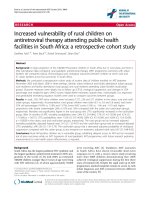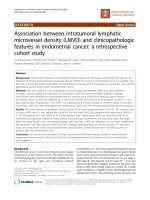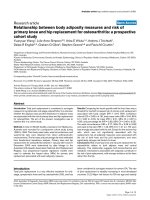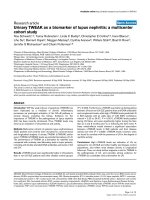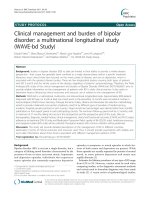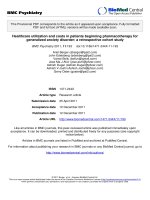Lower blood pressure and risk of cisplatin nephrotoxicity: A retrospective cohort study
Bạn đang xem bản rút gọn của tài liệu. Xem và tải ngay bản đầy đủ của tài liệu tại đây (653.3 KB, 8 trang )
Komaki et al. BMC Cancer (2017) 17:144
DOI 10.1186/s12885-017-3135-6
RESEARCH ARTICLE
Open Access
Lower blood pressure and risk of cisplatin
nephrotoxicity: a retrospective cohort study
Kazumi Komaki1, Tetsuro Kusaba1, Mai Tanaka1, Hiroshi Kado1, Yayoi Shiotsu1, Masahiro Matsui2, Atsushi Shiozaki3,
Hiroshi Nakano2, Takeshi Ishikawa4, Hitoshi Fujiwara3, Hideyuki Konishi4, Yoshito Itoh4, Satoaki Matoba1,5
and Keiichi Tamagaki1*
Abstract
Background: The pathophysiological mechanisms of cisplatin nephrotoxicity include the reduction of renal blood
flow, as well as tubular epithelial cell toxicity. The objective of this study was to investigate the influence of lower
blood pressure and decreased food intake on the incidence of cisplatin nephrotoxicity.
Methods: We conducted a retrospective cohort study at a university hospital between 2011 and 2012. We identified
hospitalized adult patients with head and neck cancer, esophageal cancer, or gastric cancer, who received intravenous
cisplatin administration. The primary outcome was the incidence of cisplatin nephrotoxicity defined as the increase in
serum creatinine after cisplatin administration more than 1.5 times from baseline.
Results: The study participants included 182 patients, in whom we observed a total of 442 cycles of cisplatin
chemotherapy. The incidence of cisplatin nephrotoxicity was observed in 41 of 182 cycles with initial administration.
Multivariate logistic regression analysis showed that systolic blood pressure was independently associated with cisplatin
nephrotoxicity (adjusted odds ratio 0.75, 95% confidence interval 0.57 to 0.95 for each 10 mmHg). The use of reninangiotensin system (RAS) inhibitors was also associated with cisplatin nephrotoxicity (3.39, 1.30 to 8.93). Among quartiles
of systolic blood pressure in all cycles of chemotherapy, the incidence of nephrotoxicity in the lower blood pressure
group was significantly higher than that in the higher blood pressure group for patients taking non-solid food (P = 0.037)
, while there was no significant difference for patients taking solid food (P = 0.67).
Conclusions: Lower blood pressure and the use of RAS inhibitors were associated with the incidence of cisplatin
nephrotoxicity, and lower blood pressure had a greater influence on nephrotoxicity in patients who could not take
solid food. Discontinuation of antihypertensive medication including RAS inhibitors before cisplatin chemotherapy
should be considered, which may be beneficial for patients with lower blood pressure.
Keywords: Blood pressure, Cisplatin, Food intake, Nephrotoxicity, Renin-angiotensin system (RAS) inhibitor
Background
Cisplatin is a platinum-based anticancer drug widely used
to treat various types of cancer and contributes to the improvement in outcomes like 5-year survival. However, side
effects of cisplatin including ototoxicity, neurotoxicity, nausea, and myelosuppression frequently occur, and the main
dose-limiting side effect is nephrotoxicity [1, 2]. Previous
reports showed that cisplatin nephrotoxicity occurred in
* Correspondence:
1
Department of Nephrology, Graduate School of Medical Science, Kyoto
Prefectural University of Medicine, 465 Kajii-cho, Kamigyo-ku, Kyoto 602-8566,
Japan
Full list of author information is available at the end of the article
approximately 7–29% of patients and several risk factors were reported [3–6]. For example, de Jongh et al.
reported that age, female gender, smoking, paclitaxel
co-administration, hypoalbuminemia were the risk
factors of cisplatin nephrotoxicity in 400 patients with
advanced solid tumors [5]. It was also reported that
higher plasma platinum concentrations, hyperuricemia,
and hypoalbuminemia were associated with renal dysfunction due to cisplatin [7–9].
Though hydration, monitoring of renal function, and
adjustment of cisplatin doses depending on renal function
[10, 11] are commonly performed in usual clinical practice, specific therapeutic approaches for the prevention
© The Author(s). 2017 Open Access This article is distributed under the terms of the Creative Commons Attribution 4.0
International License ( which permits unrestricted use, distribution, and
reproduction in any medium, provided you give appropriate credit to the original author(s) and the source, provide a link to
the Creative Commons license, and indicate if changes were made. The Creative Commons Public Domain Dedication waiver
( applies to the data made available in this article, unless otherwise stated.
Komaki et al. BMC Cancer (2017) 17:144
and treatment of cisplatin nephrotoxicity has not been
established yet. To ameliorate cisplatin nephrotoxicity, numerous approaches such as blocking inflammation, injury
signaling, and cell death pathway have been reported in
animal models or cultured cells [12–14]. However, whether
these approaches are applicable to human patients is still
unknown [1, 10].
The pathophysiological mechanisms of cisplatin nephrotoxicity include its direct tubular epithelial cell toxicity as
well as the reduction of renal blood flow as a consequence
of endothelial dysfunction and vasoconstriction [15, 16].
However, there are few reports in literature that have
assessed the influence of hemodynamic conditions such as
lower blood pressure and decreased food intake on cisplatin
nephrotoxicity [17]. Thus, we hypothesized that risk factors
such as lower blood pressure and decreased food intake deteriorate cisplatin nephrotoxicity by reducing renal blood
flow despite routine administration of hydration.
In this study, we retrospectively reviewed a cohort of patients treated with cisplatin-based chemotherapy for head
and neck cancer, esophageal cancer, or gastric cancer. The
subject selection criteria were determined according to
the following two reasons: patients with these types of
cancer tend to decrease their food intake from trismus,
dysphagia, or gastrointestinal symptoms and these cancers
are similar in cisplatin dosage and administration interval.
The objective of this study was to investigate the influence
of lower blood pressure and decreased food intake on the
incidence of cisplatin nephrotoxicity.
Methods
Study design and participants
We conducted a retrospective cohort study at University
Hospital, Kyoto Prefectural University of Medicine,
Kyoto, Japan. By searching electronic medical records,
we identified hospitalized patients aged 18 years or older
with head and neck cancer, esophageal cancer, or gastric
cancer, who received intravenous cisplatin administration between January 2011 and December 2012. The following patients were excluded from the study: patients
who received cisplatin before the observation period,
those with a history of previous cisplatin administration
at other hospitals, those with an interval of cisplatin administration of less than 2 weeks, and those receiving
maintenance dialysis.
We analyzed the incidence of cisplatin nephrotoxicity in
the first cycle of cisplatin chemotherapy and the relationship of potential risk factors to the incidence of cisplatin
nephrotoxicity. Then, we evaluated all cycles of cisplatin
chemotherapy during the observation period to investigate
the relationship of lower blood pressure and decreased
food intake to the incidence of cisplatin nephrotoxicity,
because these factors can vary among cycles of chemotherapy even in the same patient. The study was approved
Page 2 of 8
by the Ethics Committee on Human Research of Kyoto
Prefectural University of Medicine and was carried out in
accordance with the Declaration of Helsinki. Patient records/information was anonymized and de-identified prior
to analysis.
Outcomes and follow-up
The primary outcome was the incidence of cisplatin
nephrotoxicity defined as the increase in serum creatinine
after cisplatin administration more than 1.5 times baseline
according to the Common Terminology Criteria for Adverse Events (CTCAE) version 4.0 [18]. We used serum
creatinine, measured prior to each cycle of cisplatin administration as the baseline value, and collected the highest serum creatinine in the first 4 weeks of the cycle.
Data collection
Baseline characteristics of patients were extracted from
electronic medical records as follows: age, sex, smoking
status (current and former, never), history of hypertension, history of diabetes, history of cardiovascular disease, cancer types, and combined anticancer drugs.
Cardiovascular disease was defined as angina or myocardial infarction, referring to a previous report [19]. The
clinical parameters below were collected at each cycle of
chemotherapy: height, weight, body mass index (BMI),
body surface area (BSA), cisplatin dose, cumulative cisplatin dose, cycle number, combination of anticancer
drugs, amount of hydration, diuretics, food form (solid,
non-solid), amount of food intake, and antihypertensive
medications including calcium channel blockers and
renin-angiotensin system (RAS) inhibitors. We served
food containing 1600–1800 kcal, 6–9 g of NaCl daily
and less than 30% of food intake was arbitrarily defined
as “low food intake”. Non-solid food was defined as liquid food or food which was minced or pasted. Nonsolid food was served when the patients could not eat
solid food because of nausea or gastro-intestinal obstruction due to the cancer. All patients received the drug
within the manufacturer’s recommended dose and the
hydration protocol that is routine in our institute. We
collected systolic and diastolic blood pressure and baseline laboratory data such as serum creatinine, C-reactive
protein (CRP), serum albumin, and hemoglobin measured prior to cisplatin administration.
Statistical analysis
Data are shown as number (percentage) for categorical
variables and mean ± standard deviation (SD) for continuous variables. Categorical variables were compared
using chi-square tests or Fisher’s exact tests for small
sample sizes. Chi-square test with Bonferroni correction
was used for multiple comparisons. Continuous variables
were compared using a Welch’s t test.
Komaki et al. BMC Cancer (2017) 17:144
Multivariate logistic regression analysis was performed
to evaluate the influence of clinical variables on cisplatin
nephrotoxicity in the first cycle of chemotherapy. The
variables included age, sex, cisplatin dose per BSA, food
form (solid, non-solid), systolic blood pressure, and the
use of RAS inhibitors. Data of logistic regression analysis
are given as adjusted odds ratio (OR) with a 95% confidence interval (CI) and P value.
To examine the relationship between blood pressure
and nephrotoxicity, all cycles were grouped into quartiles based on systolic blood pressure. The incidence of
nephrotoxicity and the prevalence of antihypertensive
medication use in each group were calculated. Then, the
relationship between cisplatin nephrotoxicity, quartiles
of systolic blood pressure, and food form (solid or nonsolid food) were analyzed.
Differences were determined to be significant when
the two-sided P value was less than 0.05. Statistical analyses were performed using JMP software, Version 10
(SAS Institute Inc., Cary, NC).
Page 3 of 8
Table 1 Baseline characteristics for study participants
Characteristic
All patients
(n = 182)
Age (years)
65.1 ± 9.4
Male sex
135 (74.2)
Smoker
139 (76.4)
Hypertension
67 (36.8)
Antihypertensive medication
51 (28.0)
Calcium channel blockers
35 (19.2)
RAS inhibitors
31 (17.0)
Others
14 (7.7)
Diabetes
25 (13.7)
Cardiovascular disease
10 (5.5)
Cancer types
Esophagus
82 (45.1)
Head and neck
77 (42.3)
Stomach
23 (12.6)
Combined anticancer drugs
138 (75.8)
5-FU
108 (59.3)
Results
TS-1
19 (10.4)
Study participants
DOC
14 (7.7)
During the study period, 267 patients were assessed for eligibility. Figure 1 shows the flowchart of study participants.
We excluded 85 patients from analysis due to following
reasons: 47 received cisplatin before the observation period,
20 received cisplatin at other hospitals, 15 with interval of
cisplatin administration less than 2 weeks, and 3 receiving
maintenance dialysis. As a result, the study participants included 182 patients (135 men, 47 women), in whom we observed a total of 442 cycles of cisplatin administration
(182 cycle 1, 139 cycle 2, 56 cycle 3, 65 cycle 4 or more).
The baseline characteristics for study participants are listed
in Table 1; mean age was 65.1 years, and 74.2% were men.
Cancer types were head and neck cancer (42.3%), esophageal cancer (45.1%), and gastric cancer (12.6%).
CPT-11
5 (2.7)
Capecitabine
5 (2.7)
Fig. 1 Flowchart of participants analyzed in this study
Data are shown as number (percentage) or mean ± standard deviation. RAS
renin-angiotensin system, 5-FU 5-fluorouracil, TS-1 tegafur gimeracil oteracil
potassium, DOC docetaxel, CPT-11 irinotecan
Development of cisplatin nephrotoxicity
The incidence of cisplatin nephrotoxicity was observed
in 41 of 182 cycles with initial administration, in which
14 patients discontinued following cisplatin chemotherapy. In addition, cisplatin nephrotoxicity was observed
in 71 of the total 442 cycles; 8 patients developed multiple episodes of nephrotoxicity (once: 54 patients, twice:
7 patients, three times: 1 patient).
Komaki et al. BMC Cancer (2017) 17:144
Page 4 of 8
Risk factors for cisplatin nephrotoxicity
To investigate the relevant factors for developing cisplatin
nephrotoxicity, we compared the clinical characteristics
for patients with and without subsequent nephrotoxicity
in the first cycle (Table 2). Systolic blood pressure was significantly lower and the use of RAS inhibitors was significantly higher in the group with subsequent nephrotoxicity.
There was no statistically significant difference in cisplatin
dose, amount of hydration, non-solid food, or decreased
food intake between the two groups.
To further investigate the risk factors for developing
nephrotoxicity, we performed multivariate logistic regression analysis and found that systolic blood pressure
was independently associated with cisplatin nephrotoxicity (adjusted OR 0.75, 95% CI 0.57 to 0.95 for each
10 mmHg, P = 0.020; Table 3). In addition, the use of
RAS inhibitors was observed in 17.0% of the cycles and
Table 3 Multivariate logistic regression analysis of clinical
variables for cisplatin nephrotoxicity in the first cycle
Variable
Adjusted OR (95%CI)
P value
Age
1.00 (0.96–1.05)
0.87
Male sex
1.91 (0.79–5.05)
0.15
2
Cisplatin dose, 10 mg/m
1.29 (0.92–1.87)
0.14
Non-solid food
2.09 (0.99–4.50)
0.054
Systolic blood pressure, 10 mmHg
0.75 (0.57–0.95)
0.02
RAS inhibitors use
3.39 (1.30–8.93)
0.01
Multivariate logistic regression analysis was performed to evaluate the
influence of clinical variables on cisplatin nephrotoxicity in the first cycle of
chemotherapy (n = 182)
OR odds ratio, CI confidence interval, RAS renin-angiotensin system
was associated with cisplatin nephrotoxicity (3.39, 1.30
to 8.93, P = 0.013).
Lower blood pressure as a risk of cisplatin nephrotoxicity
Table 2 Clinical characteristics for patients with and without
subsequent nephrotoxicity in the first cycle
Characteristic
Nephrotoxicity
(+)
Nephrotoxicity
(−)
(n = 41)
(n = 141)
P value
Age (years)
65.7 ± 9.0
65.0 ± 9.6
0.69
Male sex
33 (80.5)
102 (72.3)
0.12
BMI (kg/m2)
20.4 ± 3.2
21.0 ± 3.3
0.30
Systolic blood pressure
(mmHg)
114.3 ± 15.7
119.8 ± 15.4
0.0498
Diastolic blood pressure
(mmHg)
68.6 ± 9.1
71.7 ± 11.4
0.08
Antihypertensive medication 14 (34.2)
37 (26.2)
0.32
Calcium channel blockers
9 (22.0)
26 (18.4)
0.62
RAS inhibitors
12 (29.3)
19 (13.5)
0.02
Others
5 (12.2)
9 (6.4)
0.22
Cardiovascular disease
1 (2.4)
9 (6.4)
0.33
Combination of anticancer
drugs
32 (78.1)
106 (75.2)
0.71
Cisplatin dose (mg/m2)
73.4 ± 9.6
69.8 ± 13.7
0.054
Amount of hydration
(mL/day)
3,437 ± 319
3,345 ± 595
0.20
Diuretics
38 (92.7)
127 (90.1)
0.61
Non-solid food
21 (51.2)
50 (35.5)
0.07
Decreased food intake
(≤50%)
9 (22.0)
18 (12.8)
0.15
0.69 ± 0.19
0.70 ± 0.17
0.83
Laboratory data
Creatinine (mg/dL)
CRP (mg/dL)
1.01 ± 1.77
0.87 ± 1.77
0.66
Albumin (g/dL)
3.80 ± 0.51
3.91 ± 0.49
0.22
Hemoglobin (g/dL)
12.7 ± 1.6
12.7 ± 1.8
0.83
Data are shown as number (percentage) or mean ± standard deviation. BMI
body mass index, RAS renin-angiotensin system, CRP C-reactive protein
Next, we closely focused on the relationship between
blood pressure and decreased food intake to the incidence of cisplatin nephrotoxicity. We evaluated all cycles
of chemotherapy during the observation period, because
the hemodynamic conditions can vary among cycles of
chemotherapy even in the same patient. Systolic blood
pressure was significantly lower and the proportion of
patients who were taking non-solid food was significantly higher in the group with subsequent nephrotoxicity (Table 4).
Then, we divided all cycles into quartiles of systolic
blood pressure. As demonstrated in Fig. 2, the incidence
of nephrotoxicity was significantly higher in the lower
quartile than in the higher quartile (relative risk 2.50,
95% CI 1.01 to 6.20, P = 0.004). Despite low blood pressure, approximately 20% of subjects continued antihypertensive medication in the lower quartile. Additionally,
there was no significant difference in the prevalence of
antihypertensive medication use between quartiles.
Finally, we classified all cycles according to food form
(solid or non-solid food) and quartiles of systolic blood
pressure (Quartile 1: ≤106 mmHg, Quartile 2: 107 to
117 mmHg, Quartile 3: 118 to 127 mmHg, Quartile 4:
≥128 mmHg), and compared the incidence of cisplatin
nephrotoxicity among these groups (Fig. 3). For patients
taking solid food, the incidence of cisplatin nephrotoxicity
in the lower blood pressure group was slightly higher than
that in the higher blood pressure group (Quartile 1 = 16.4%,
Quartile 2 = 12.1%, Quartile 3 = 11.5%, Quartile 4 =
9.9%, P = 0.67). By contrast, for patients taking nonsolid food, the incidence of nephrotoxicity in the lower
blood pressure group was significantly higher than that
in the higher blood pressure group (Quartile 1 = 32.7%,
Quartile 2 = 23.9%, Quartile 3 = 17.4%, Quartile 4 =
7.9%, P = 0.037). Lower blood pressure had a greater influence on nephrotoxicity in patients taking non-solid
Komaki et al. BMC Cancer (2017) 17:144
Page 5 of 8
Table 4 Clinical characteristics for all cycles of chemotherapy
with and without subsequent nephrotoxicity
Characteristic
Nephrotoxicity
(+)
Nephrotoxicity
(−)
P value
(n = 71)
(n = 371)
BMI (kg/m2)
20.0 ± 3.3
20.6 ± 3.1
0.12
Systolic blood pressure
(mmHg)
112.0 ± 14.7
118.5 ± 15.1
<0.001
Diastolic blood pressure
(mmHg)
68.3 ± 9.7
71.6 ± 11.1
0.01
Antihypertensive
medication
20 (28.2)
80 (21.6)
0.22
Calcium channel
blockers
13 (18.3)
58 (15.7)
0.60
RAS inhibitors
14 (19.7)
43 (11.6)
0.08
Others
7 (9.9)
18 (4.9)
0.10
Combination of anticancer
drugs
54 (76.1)
299 (80.6)
0.42
Cisplatin dose (mg/m2)
71.4 ± 10.5
68.2 ± 13.3
0.03
Cumulative cisplatin dose
(mg/m2)
135 ± 83
152 ± 101
0.13
Amount of hydration
(mL/day)
3,441 ± 343
3,391 ± 532
0.31
Diuretics
66 (93.0)
345 (93.2)
0.93
Non-solid food
38 (53.5)
141 (38.0)
0.02
Decreased food intake
(≤50%)
12 (16.9)
62 (16.7)
0.97
Creatinine (mg/dL)
0.70 ± 0.20
0.74 ± 0.21
0.12
CRP (mg/dL)
1.04 ± 1.65
0.66 ± 1.45
0.08
Albumin (g/dL)
3.83 ± 0.46
3.87 ± 0.45
0.43
Hemoglobin (g/dL)
12.1 ± 1.6
11.9 ± 1.8
0.37
Laboratory data
Data are shown as number (percentage) or mean ± standard deviation. BMI
body mass index, RAS renin-angiotensin system, CRP C-reactive protein
food than those taking solid food. For the lower quartile
(Quartile 1), the incidence of nephrotoxicity in patients
taking non-solid food was significantly higher than that in
patients taking solid food (relative risk 1.98, 95% CI 1.03
to 3.82, P = 0.037).
Discussion
This retrospective cohort study addresses the risk of
cisplatin nephrotoxicity and especially focuses on the
impact of lower blood pressure and decreased food
intake. In this study, we verified that lower blood pressure prior to cisplatin administration, and the use of
RAS inhibitors were associated with the incidence of cisplatin nephrotoxicity. We also showed that non-solid
food intake is a risk of cisplatin nephrotoxicity in case of
coincidence with lower blood pressure.
Our study showed that lower blood pressure, especially
lower than 107 mmHg, prior to cisplatin administration
was a significant risk for the incidence of cisplatin nephrotoxicity. In terms of cisplatin metabolism, the unbound
cisplatin in the plasma is freely filtered by the glomerulus
and is not reabsorbed [11, 20]. On the other hand, circulating cisplatin is transported into proximal tubular epithelial cells by the organic cation transporter 2 (OCT2)
which is highly expressed in the basolateral membrane of
proximal tubules, which depends on the serum cisplatin
concentration [21]. The renal accumulation of cisplatin
causes direct tubular epithelial cytotoxicity [22, 23]. In patients with lower blood pressure, it is expected that urinary excretion of cisplatin is delayed by a decreased
glomerular filtration rate (GFR). As a result, it takes a longer time for the serum cisplatin concentration to drop off
and for cisplatin uptake into tubular epithelial cells
through OCT2 to increase, which eventually accelerates
cisplatin nephrotoxicity. The pathophysiology of cisplatin
nephrotoxicity also involves vascular injury such as microangiopathy and vasoconstriction, which causes a reduction
of renal blood flow and GFR [16, 17]. Moreover, it is reported that an increase of sodium excretion in urine and
polyuria occur after cisplatin administration [24, 25],
which induce further reduction of blood volume and a
subsequent decrease in renal blood flow.
Regarding antihypertensive drugs, this study also suggests that the use of RAS inhibitors was associated with
cisplatin nephrotoxicity independent of systolic blood
pressure. RAS is activated when the renal perfusion pressure is decreased by hypotension or volume depletion
[26]. Angiotensin II increases systemic blood pressure by
contracting arterioles, promotes sodium reabsorption in
renal tubules, and increases extracellular fluid [27]. Consequently, angiotensin II maintains glomerular filtration
pressure and GFR [26]. An experimental study using dogs
showed a dissociation of autoregulation in renal blood
flow and GFR was introduced by RAS inhibitors; GFR dramatically dropped off according to the decrease in renal
perfusion pressure while renal blood flow was preserved
in the same condition [28–30]. In fact, patients taking
RAS inhibitors are at high risk of developing acute kidney
injury during intercurrent illnesses such as volume depletion, because the contraction of efferent arterioles is inhibited by RAS inhibitors [31]. In addition, RAS can be
activated by volume depletion from sodium wasting or
polyuria and vascular contraction after cisplatin administration. It was reported that plasma renin activity and
plasma aldosterone concentrations were elevated after cisplatin administration [32]. RAS inhibitors may suppress
this humoral response, resulting in exacerbating renal ischemia and delaying cisplatin excretion by inhibiting RAS
activation to maintain GFR.
On the other hand, Saleh et al. reported that the angiotensin receptor blocker losartan has protective effects
against cisplatin-induced nephrotoxicity in a rat model
Komaki et al. BMC Cancer (2017) 17:144
Page 6 of 8
Fig. 2 Incidence of nephrotoxicity and prevalence of antihypertensive medication use by quartiles of systolic blood pressure. All cycles were divided
into quartiles of systolic blood pressure (n = 442). CI, confidence interval
[33]. In that study, losartan did not affect cisplatin uptake
by the kidney, but significantly counteracted cisplatininduced lipid peroxidation and glutathione depletion. They
concluded that the renoprotective effect is due to antioxidant properties [33]. In our study, in subjects who tend to
present with volume depletion from decreased food intake,
the harmful effect on glomerular filtration pressure might
exceed the antioxidative effect of RAS inhibitors. Further
investigation is needed to address this issue.
Fig. 3 Incidence of nephrotoxicity according to food form and quartiles
of systolic blood pressure. All cycles were classified according to food
form (solid or non-solid food) and quartiles of systolic blood pressure
(n = 442). Chi-square test revealed as; *significant differences between
patients taking solid food and non-solid food in Quartile 1 (P < 0.05),
and **significant differences between Quartile 1 and Quartile 4 in
patients taking non-solid food (P < 0.0125 after Bonferroni correction)
Concerning food intake, the prevalence of appetite loss is
high among cancer patients and various causes are involved. For example, emotional distress by the diagnosis or
treatment [34], active inflammatory reaction caused by
cancer, chemotherapy or irradiation may decrease the appetite [35]. Of note, patients of head and neck cancer frequently developed taste and smell disturbance because of
cancer involvement in taste nerves or local taste bud injury
caused by irradiation or surgery, which remarkably decrease the patient’s quality of life. Unless essential minerals
are appropriately supplied, lower food intake reflects the
reduction of sodium intake, resulting in a notable decrease
in blood pressure and subsequent increase in the risk of
cisplatin nephrotoxicity. In fact, our study demonstrated
that non-solid food intake was a risk of cisplatin nephrotoxicity only in case of lower blood pressure. From these
findings, we have to pay much attention to food intake and
subsequent lower blood pressure in order to avoid cisplatin
nephrotoxicity.
This study showed no significant association between
cisplatin dose and nephrotoxicity in multivariate analysis.
Reece et al. reported that the peak plasma level of ultrafilterable platinum correlated with a decline in creatinine
clearance after cisplatin therapy in 22 cancer patients who
received cisplatin [7]. Lagrange et al. also reported that
platinum concentration was only related to the incident
rate of nephrotoxicity and that platinum concentration
was related to pretreatment renal function, BSA, cisplatin
dose, number of administration in 121 cycles of 62 cancer
patients who received cisplatin every 3 weeks [8]. In our
institute, cisplatin dose is empirically reduced in the presence of pre-existing renal dysfunction [36]. It is suggested
that cisplatin dose adjustment for renal impairment hides
possible associations between cisplatin dose and nephrotoxicity in this study.
Komaki et al. BMC Cancer (2017) 17:144
Our study has several limitations. First, our analysis is
lacking an appropriate control group such as patients who
maintained adequate food intake or those with higher blood
pressure. Therefore, we classified patients according to food
form and blood pressure, and evaluated their association
with the outcome within a cohort. Second, the study also
has the inherent limitations of a retrospective study. To
quantify feeding status, we used two parameters: food form
(solid, non-solid) and amount of food intake. The medical
records of these data were partially semi-quantitative. The
quantitative indicators of food intake or other parameters
for nutritional status are needed for further investigation.
Third, serum creatinine, used for primary outcome in this
study, can overestimate basal renal function and underestimate renal prognosis in patients with weight loss due to
cancer. To avoid the latter problem, we evaluated shortterm creatinine changes within 4 weeks. Finally, there was
the lack of longitudinal data including blood pressure and
body weight. These data can elucidate the change in distribution of blood pressure and relevant factors in cancer
patients.
Conclusions
In conclusion, our study demonstrated that lower blood
pressure prior to cisplatin administration and the use of
RAS inhibitors was associated with the incidence of cisplatin nephrotoxicity, and lower blood pressure had a
greater influence on nephrotoxicity in patients who could
not take solid food because of nausea or gastro-intestinal
obstruction due to the cancer. We wish to alert oncologists to the risk of cisplatin nephrotoxicity in cases of coincidence of lower blood pressure and decreased food
intake. Discontinuation of antihypertensive medication including RAS inhibitors before cisplatin chemotherapy
should be considered, which may be beneficial for patients
with lower blood pressure.
Additional file
Additional file 1: Original data of 442 cycles of cisplatin chemotherapy
in 182 patients. (XLSX 88 kb)
Abbreviations
5-FU: 5-fluorouracil; BMI: Body mass index; BSA: Body surface area; CI: Confidence
interval; CPT-11: Irinotecan; CRP: C-reactive protein; CTCAE: Common Terminology
Criteria for Adverse Events; DOC: Docetaxel; GFR: Glomerular filtration rate;
OCT2: Organic cation transporter 2; OR: Odds ratio; RAS: Renin-angiotensin system;
SD: Standard deviation; TS-1: Tegafur gimeracil oteracil potassium
Acknowledgements
None.
Funding
No external funding.
Authors’ contributions
KK and KT conceived and designed the experiments. KK, MO, HK and YS
collected the data. KK, TK and KT analyzed and interpreted the data. KK, TK
Page 7 of 8
and KT wrote the paper. MO, HK, YS, MM, AS, HN, TI, HF, HK, YI and SM
contributed in critical revision of the manuscript for important intellectual
content. All authors have read and approved the final manuscript.
Competing interests
The authors declare that they have no competing interests.
Availability of data and materials
The dataset supporting the conclusions of this article is included within the
article and its Additional file 1.
Consent for publication
Not applicable.
Ethics approval and consent to participate
The study was approved by the Ethics Committee on Human Research of
Kyoto Prefectural University of Medicine and was carried out in accordance
with the Declaration of Helsinki, and the requirement for informed consent
was waived because of the retrospective design.
Author details
1
Department of Nephrology, Graduate School of Medical Science, Kyoto
Prefectural University of Medicine, 465 Kajii-cho, Kamigyo-ku, Kyoto 602-8566,
Japan. 2Department of Otolaryngology-Head and Neck Surgery, Kyoto
Prefectural University of Medicine, 465 Kajii-cho, Kamigyo-ku, Kyoto 602-8566,
Japan. 3Division of Digestive Surgery, Department of Surgery, Kyoto
Prefectural University of Medicine, 465 Kajii-cho, Kamigyo-ku, Kyoto 602-8566,
Japan. 4Molecular Gastroenterology and Hepatology, Graduate School of
Medical Science, Kyoto Prefectural University of Medicine, 465 Kajii-cho,
Kamigyo-ku, Kyoto 602-8566, Japan. 5Department of Cardiovascular Medicine,
Graduate School of Medical Science, Kyoto Prefectural University of Medicine,
465 Kajii-cho, Kamigyo-ku, Kyoto 602-8566, Japan.
Received: 5 July 2016 Accepted: 14 February 2017
References
1. Pabla N, Dong Z. Cisplatin nephrotoxicity: mechanisms and renoprotective
strategies. Kidney Int. 2008;73:994–1007.
2. Arany I, Safirstein RL. Cisplatin nephrotoxicity. Semin Nephrol. 2003;23:460–4.
3. Stewart DJ, Dulberg CS, Mikhael NZ, Redmond MD, Montpetit VA, Goel R.
Association of cisplatin nephrotoxicity with patient characteristics and cisplatin
administration methods. Cancer Chemother Pharmacol. 1997;40:293–308.
4. Yao X, Panichpisal K, Kurtzman N, Nugent K. Cisplatin nephrotoxicity: a
review. Am J Med Sci. 2007;334:115–24.
5. de Jongh FE, van Veen RN, Veltman SJ, de Wit R, van der Burg ME, van den
Bent MJ, et al. Weekly high-dose cisplatin is a feasible treatment option:
analysis on prognostic factors for toxicity in 400 patients. Br J Cancer. 2003;
88:1199–206.
6. Moon HH, Seo KW, Yoon KY, Shin YM, Choi KH, Lee SH. Prediction of
nephrotoxicity induced by cisplatin combination chemotherapy in gastric
cancer patients. World J Gastroenterol. 2011;17:3510–7.
7. Reece PA, Stafford I, Russell J, Khan M, Gill PG. Creatinine clearance as a
predictor of ultrafilterable platinum disposition in cancer patients treated
with cisplatin: relationship between peak ultrafilterable platinum plasma
levels and nephrotoxicity. J Clinical Oncol. 1987;5:304–9.
8. Lagrange JL, Medecin B, Etienne MC, Pivot X, Cassuto-Viguier E, Renee N, et
al. Cisplatin nephrotoxicity: a multivariate analysis of potential predisposing
factors. Pharmacotherapy. 1997;17:1246–53.
9. Nanji AA, Stewart DJ, Mikhael NZ. Hyperuricemia and hypoalbuminemia
predispose to cisplatin-induced nephrotoxicity. Cancer Chemother
Pharmacol. 1986;17:274–6.
10. dos Santos NA, Carvalho Rodrigues MA, Martins NM, dos Santos AC.
Cisplatin-induced nephrotoxicity and targets of nephroprotection: an
update. Arch Toxicol. 2012;86:1233–50.
11. Launay-Vacher V, Rey JB, Isnard-Bagnis C, Deray G, Daouphars M. Prevention
of cisplatin nephrotoxicity: state of the art and recommendations from the
European Society of Clinical Pharmacy Special Interest Group on Cancer
Care. Cancer Chemother Pharmacol. 2008;61:903–9.
12. Ramesh G, Reeves WB. Salicylate reduces cisplatin nephrotoxicity by
inhibition of tumor necrosis factor-alpha. Kidney Int. 2004;65:490–9.
Komaki et al. BMC Cancer (2017) 17:144
13. Arany I, Megyesi JK, Kaneto H, Price PM, Safirstein RL. Cisplatin-induced cell
death is EGFR/src/ERK signaling dependent in mouse proximal tubule cells.
Am J Physiol Ren Physiol. 2004;287:F543–9.
14. Faubel S, Ljubanovic D, Reznikov L, Somerset H, Dinarello CA, Edelstein CL.
Caspase-1-deficient mice are protected against cisplatin-induced apoptosis
and acute tubular necrosis. Kidney Int. 2004;66:2202–13.
15. Luke DR, Vadiei K, Lopez-Berestein G. Role of vascular congestion in cisplatininduced acute renal failure in the rat. Nephrol Dial Transplant. 1992;7:1–7.
16. Winston JA, Safirstein R. Reduced renal blood flow in early cisplatin-induced
acute renal failure in the rat. Am J Phys. 1985;249:F490–6.
17. Sanchez-Gonzalez PD, Lopez-Hernandez FJ, Lopez-Novoa JM, Morales AI. An
integrative view of the pathophysiological events leading to cisplatin
nephrotoxicity. Crit Rev Toxicol. 2011;41:803–21.
18. Common Terminology Criteria for Adverse Events (CTCAE) Version 4.0.
Available: />QuickReference_5x7.pdf. Accessed 16 Feb 2017.
19. Mizuno T, Ishikawa K, Sato W, Koike T, Kushida M, Miyagawa Y, et al. The risk
factors of severe acute kidney injury induced by cisplatin. Oncology. 2013;
85:364–9.
20. Safirstein R, Miller P, Guttenplan JB. Uptake and metabolism of cisplatin by
rat kidney. Kidney Int. 1984;25:753–8.
21. Ishida S, Lee J, Thiele DJ, Herskowitz I. Uptake of the anticancer drug
cisplatin mediated by the copper transporter Ctr1 in yeast and mammals.
Proc Natl Acad Sci U S A. 2002;99:14298–302.
22. Ludwig T, Riethmuller C, Gekle M, Schwerdt G, Oberleithner H. Nephrotoxicity
of platinum complexes is related to basolateral organic cation transport.
Kidney Int. 2004;66:196–202.
23. Yonezawa A, Masuda S, Nishihara K, Yano I, Katsura T, Inui K. Association
between tubular toxicity of cisplatin and expression of organic cation
transporter rOCT2 (Slc22a2) in the rat. Biochem Pharmacol. 2005;70:1823–31.
24. Hutchison FN, Perez EA, Gandara DR, Lawrence HJ, Kaysen GA. Renal salt
wasting in patients treated with cisplatin. Ann Intern Med. 1988;108:21–5.
25. Cao L, Joshi P, Sumoza D. Renal salt-wasting syndrome in a patient with
cisplatin-induced hyponatremia: case report. Am J Clin Oncol. 2002;25:344–6.
26. Denton KM, Fennessy PA, Alcorn D, Anderson WP. Morphometric analysis of
the actions of angiotensin II on renal arterioles and glomeruli. Am J Phys.
1992;262:F367–72.
27. Ichikawi I, Harris RC. Angiotensin actions in the kidney: renewed insight into
the old hormone. Kidney Int. 1991;40:583–96.
28. Hall JE, Guyton AC, Jackson TE, Coleman TG, Lohmeier TE, Trippodo NC.
Control of glomerular filtration rate by renin-angiotensin system. Am J Phys.
1977;233:F366–72.
29. Hall JE, Coleman TG, Guyton AC, Balfe JW, Salgado HC. Intrarenal role of
angiotensin II and [des-Asp1]angiotensin II. Am J Phys. 1979;236:F252–9.
30. Hricik DE, Dunn MJ. Angiotensin-converting enzyme inhibitor-induced renal
failure: causes, consequences, and diagnostic uses. J Am Soc Nephrol. 1990;
1:845–58.
31. Stirling C, Houston J, Robertson S, Boyle J, Allan A, Norrie J, et al. Diarrhoea,
vomiting and ACE inhibitors:–an important cause of acute renal failure. J
Hum Hypertens. 2003;17:419–23.
32. Kurt E, Manavoglu O, Dilek K, Orhan B, Evrensel T. Effect of cisplatin on plasma
renin activity and serum aldosterone levels. Clin Nephrol. 1999;52:397–8.
33. Saleh S, Ain-Shoka AA, El-Demerdash E, Khalef MM. Protective effects of the
angiotensin II receptor blocker losartan on cisplatin-induced kidney injury.
Chemotherapy. 2009;55:399–406.
34. Holland JC, Rowland J, Plumb M. Psychological aspects of anorexia in
cancer patients. Cancer Res. 1977;37:2425–8.
35. Perboni S, Inui A. Anorexia in cancer: role of feeding-regulatory peptides.
Philos Trans R Soc Lond B Biol Sci. 2006;361:1281–9.
36. Kintzel PE, Dorr RT. Anticancer drug renal toxicity and elimination: dosing
guidelines for altered renal function. Cancer Treat Rev. 1995;21:33–64.
Page 8 of 8
Submit your next manuscript to BioMed Central
and we will help you at every step:
• We accept pre-submission inquiries
• Our selector tool helps you to find the most relevant journal
• We provide round the clock customer support
• Convenient online submission
• Thorough peer review
• Inclusion in PubMed and all major indexing services
• Maximum visibility for your research
Submit your manuscript at
www.biomedcentral.com/submit

